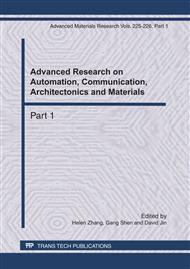p.465
p.469
p.475
p.479
p.483
p.488
p.492
p.496
p.500
Research and Implementation of Conglutinated Macrophage Image Segmentation Based on Improved Watershed Algorithm
Abstract:
In the process of macrophage image manufacture, cell adhesion often appears because of equipment or man-made reason and then influences subsequent automatic detection and analysis. The traditional watershed algorithm is easy to cause over-segmentation for the volatility of gray extremum. To overcome these phenomena, an improved watershed algorithm which was based on macrophages image segmentation was introduced in this paper. The simulation results show that the improved algorithm can effectively segment adhesive macrophages and restrain the over-segmentation phenomena with an acceptable computation speed.
Info:
Periodical:
Pages:
483-487
Citation:
Online since:
April 2011
Authors:
Price:
Сopyright:
© 2011 Trans Tech Publications Ltd. All Rights Reserved
Share:
Citation:


